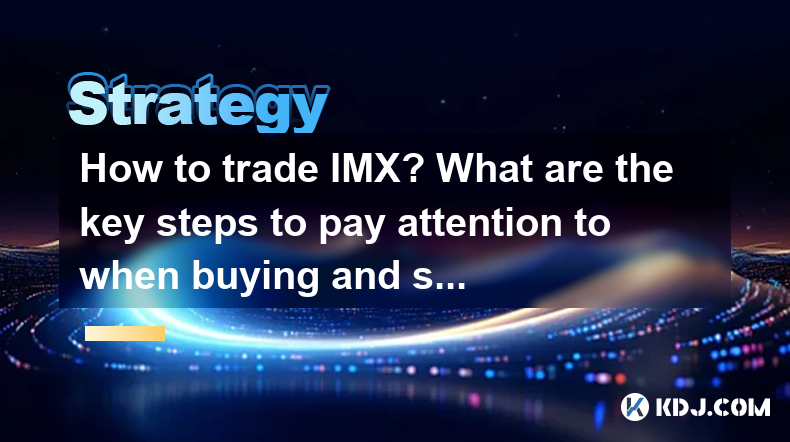-
 bitcoin
bitcoin $108842.957301 USD
-1.88% -
 ethereum
ethereum $3931.777121 USD
-1.66% -
 tether
tether $1.000186 USD
-0.03% -
 bnb
bnb $1153.250882 USD
-2.20% -
 xrp
xrp $2.367904 USD
-1.94% -
 solana
solana $186.182050 USD
-4.20% -
 usd-coin
usd-coin $0.999997 USD
0.00% -
 tron
tron $0.316949 USD
-1.00% -
 dogecoin
dogecoin $0.190780 USD
-3.12% -
 cardano
cardano $0.651324 USD
-2.67% -
 hyperliquid
hyperliquid $37.141055 USD
-0.85% -
 ethena-usde
ethena-usde $0.999224 USD
-0.09% -
 chainlink
chainlink $17.579031 USD
-2.47% -
 bitcoin-cash
bitcoin-cash $509.426284 USD
-2.79% -
 stellar
stellar $0.315298 USD
-2.93%
How to trade IMX? What are the key steps to pay attention to when buying and selling?
To trade IMX effectively, understand its fundamentals, choose a secure exchange like Binance or Coinbase, and use market or limit orders to buy and sell based on your strategy.
May 02, 2025 at 09:14 pm

Trading IMX, or Immutable X, involves understanding the cryptocurrency's fundamentals, choosing a reliable exchange platform, and executing trades effectively. This article will guide you through the essential steps to trade IMX, highlighting key considerations for buying and selling.
Understanding Immutable X (IMX)
Immutable X (IMX) is a layer-2 scaling solution for Ethereum that aims to provide instant trade confirmation, massive scalability, and zero gas fees. Before trading IMX, it's crucial to understand its purpose and potential. Research the project's whitepaper, team, and community to gauge its viability and growth potential. This foundational knowledge will help you make informed trading decisions.
Choosing a Reliable Exchange
To trade IMX, you need to select a reputable cryptocurrency exchange that lists the token. Some popular exchanges where you can find IMX include:
- Binance
- Coinbase
- Kraken
When choosing an exchange, consider factors such as security, fees, user interface, and customer support. Security is paramount; ensure the exchange has robust measures like two-factor authentication (2FA) and cold storage for funds. Fees can significantly impact your trading profitability, so compare the fee structures of different exchanges. A user-friendly interface and responsive customer support can also enhance your trading experience.
Setting Up Your Account
Once you've selected an exchange, you'll need to set up an account. Here's how:
- Visit the exchange's website and click on the 'Sign Up' or 'Register' button.
- Enter your personal information, including your name, email address, and a strong password.
- Complete the verification process, which typically involves submitting identification documents such as a passport or driver's license.
- Enable two-factor authentication (2FA) to add an extra layer of security to your account.
After setting up your account, you may need to deposit funds to start trading. Most exchanges support deposits via bank transfers, credit/debit cards, or other cryptocurrencies like Bitcoin or Ethereum.
Depositing Funds
To deposit funds into your exchange account:
- Navigate to the 'Deposit' section of the exchange.
- Choose your preferred deposit method (e.g., bank transfer, credit card, or cryptocurrency).
- Follow the on-screen instructions to complete the deposit. If you're depositing cryptocurrency, you'll need to send it to the exchange's provided wallet address.
Ensure you double-check the deposit address to avoid sending funds to the wrong place. Once your funds are deposited and confirmed, you can proceed to buy IMX.
Buying IMX
To buy IMX, follow these steps:
- Navigate to the trading section of the exchange and search for the IMX trading pair (e.g., IMX/BTC, IMX/ETH, or IMX/USDT).
- Enter the amount of IMX you want to buy and review the total cost.
- Confirm the order and wait for it to be executed. Depending on the order type (market or limit), this may happen instantly or at a specified price.
Market orders are executed immediately at the current market price, while limit orders allow you to set a specific price at which you're willing to buy. Choose the order type that aligns with your trading strategy.
Selling IMX
When you're ready to sell IMX, follow these steps:
- Navigate to the trading section and find the IMX trading pair.
- Enter the amount of IMX you want to sell and review the total proceeds.
- Confirm the order and wait for it to be executed.
Similar to buying, you can choose between market and limit orders when selling IMX. Consider your trading goals and market conditions when deciding which order type to use.
Monitoring and Managing Your Trades
After buying or selling IMX, it's important to monitor your trades and manage your portfolio effectively. Use the exchange's trading tools and charts to track IMX's price movements and market trends. Set price alerts to notify you of significant price changes, and consider using stop-loss orders to limit potential losses.
Regularly review your portfolio's performance and rebalance as needed. Diversify your investments to mitigate risk and avoid putting all your funds into a single asset like IMX.
Withdrawing Funds
If you want to withdraw funds from your exchange account:
- Navigate to the 'Withdraw' section of the exchange.
- Choose the cryptocurrency you want to withdraw (e.g., IMX, BTC, or ETH).
- Enter the amount you want to withdraw and the destination wallet address.
- Confirm the withdrawal and wait for it to be processed. Withdrawal times can vary depending on the cryptocurrency and the exchange's processing speed.
Always double-check the withdrawal address to avoid sending funds to the wrong wallet. Some exchanges may charge withdrawal fees, so be aware of these costs.
Frequently Asked Questions
Q: Can I trade IMX on decentralized exchanges (DEXs)?A: Yes, IMX can be traded on some decentralized exchanges like Uniswap. To trade on a DEX, you'll need to connect your Ethereum wallet (e.g., MetaMask) to the exchange and swap your tokens directly from your wallet.
Q: What are the risks associated with trading IMX?A: Trading IMX, like any cryptocurrency, carries risks such as market volatility, regulatory changes, and potential security breaches. Always conduct thorough research and never invest more than you can afford to lose.
Q: How can I stay updated on IMX developments?A: To stay informed about IMX, follow the official Immutable X social media channels, join their community forums, and subscribe to newsletters from reputable cryptocurrency news sources.
Q: Are there any tax implications when trading IMX?A: Yes, trading IMX can have tax implications depending on your jurisdiction. Profits from selling IMX may be subject to capital gains tax. Consult with a tax professional to understand your specific obligations.
Disclaimer:info@kdj.com
The information provided is not trading advice. kdj.com does not assume any responsibility for any investments made based on the information provided in this article. Cryptocurrencies are highly volatile and it is highly recommended that you invest with caution after thorough research!
If you believe that the content used on this website infringes your copyright, please contact us immediately (info@kdj.com) and we will delete it promptly.
- BNB & BSC: Riding the Bull Run with Strong Support
- 2025-10-18 04:25:12
- Altcoins in the Spotlight: Solana, Ethereum, and the Rise of AlphaPepe
- 2025-10-18 04:25:12
- Crypto Opportunities: Investing in SHIB and TAP for Potential Gains
- 2025-10-18 04:30:13
- XRP's Wild Ride: ETF Delays and Price Drop – What's a Crypto New Yorker to Do?
- 2025-10-18 05:05:13
- Shiba Inu and the Quest for Crypto's Highest Gains: What's Next?
- 2025-10-18 04:30:13
- Midnight, Hydra Layer 2, and the NIGHT Token: A New Dawn for Cardano?
- 2025-10-18 04:45:14
Related knowledge

Practical parameter settings for a Bitcoin multi-timeframe moving average system
Sep 18,2025 at 10:54pm
Optimizing Timeframe Combinations for Bitcoin Trading1. Selecting appropriate timeframes is crucial when building a multi-timeframe moving average sys...

How can I filter out false breakouts in Dogecoin high-frequency trading?
Sep 22,2025 at 01:00am
Understanding False Breakouts in Dogecoin Trading1. A false breakout occurs when Dogecoin's price appears to move beyond a defined support or resistan...

Techniques for identifying tops and bottoms in the Bitcoin on-chain NVT model
Sep 20,2025 at 07:54pm
Understanding the NVT Model in Bitcoin Analysis1. The Network Value to Transactions (NVT) ratio is often described as the 'P/E ratio' of the cryptocur...

What does the surge in open interest in Bitcoincoin futures mean?
Sep 20,2025 at 11:18pm
Understanding the Surge in Dogecoin Futures Open Interest1. A surge in open interest within Dogecoin futures indicates a growing number of active cont...

How can I use the Ethereum USDT premium to gauge market sentiment?
Sep 18,2025 at 11:55pm
Understanding the Ethereum USDT Premium1. The Ethereum USDT premium refers to the price difference between USDT (Tether) traded on Ethereum-based plat...

What should I do if Ethereum staking yields decline?
Sep 20,2025 at 06:18am
Understanding the Causes Behind Declining Ethereum Staking Yields1. The Ethereum network transitioned to a proof-of-stake consensus mechanism with the...

Practical parameter settings for a Bitcoin multi-timeframe moving average system
Sep 18,2025 at 10:54pm
Optimizing Timeframe Combinations for Bitcoin Trading1. Selecting appropriate timeframes is crucial when building a multi-timeframe moving average sys...

How can I filter out false breakouts in Dogecoin high-frequency trading?
Sep 22,2025 at 01:00am
Understanding False Breakouts in Dogecoin Trading1. A false breakout occurs when Dogecoin's price appears to move beyond a defined support or resistan...

Techniques for identifying tops and bottoms in the Bitcoin on-chain NVT model
Sep 20,2025 at 07:54pm
Understanding the NVT Model in Bitcoin Analysis1. The Network Value to Transactions (NVT) ratio is often described as the 'P/E ratio' of the cryptocur...

What does the surge in open interest in Bitcoincoin futures mean?
Sep 20,2025 at 11:18pm
Understanding the Surge in Dogecoin Futures Open Interest1. A surge in open interest within Dogecoin futures indicates a growing number of active cont...

How can I use the Ethereum USDT premium to gauge market sentiment?
Sep 18,2025 at 11:55pm
Understanding the Ethereum USDT Premium1. The Ethereum USDT premium refers to the price difference between USDT (Tether) traded on Ethereum-based plat...

What should I do if Ethereum staking yields decline?
Sep 20,2025 at 06:18am
Understanding the Causes Behind Declining Ethereum Staking Yields1. The Ethereum network transitioned to a proof-of-stake consensus mechanism with the...
See all articles










































































